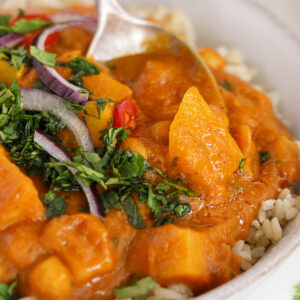Chickpea And Potato Curry (Chana Aloo)
This chickpea and potato curry (Chana Aloo) is a simple and easy, comforting plant-based dish. It's packed with flavor and comes together in just 30 minutes. Enjoy with a slice of toasted naan bread or over a bed of fluffy basmati rice!
Servings: 4 servings
Calories: 435kcal
Ingredients
- 2 tablespoon oil - see note 1
- 1 yellow onion - diced (you can also use red or white)
- 2 garlic cloves - minced
- 1 teaspoon cumin seeds
- 1 tablespoon grated ginger
- 1 teaspoon turmeric
- 1 teaspoon ground cumin
- ½ teaspoon ground coriander
- 1 teaspoon garam masala
- ½ teaspoon cayenne pepper
- 2 cans chickpeas - drained or 3 cups drained
- 1 can crushed tomatoes - 15 ounce
- 2 medium potatoes - around 1 ½ cup, cut into ½ inch cubes
- 1 ½ cup water - or vegetable broth
- 2 tablespoons cilantro - chopped
For serving
- Cilantro leaves
- Red onions
- Fresh chili
- Basmati rice
- Naan
Instructions
- Heat the oil in a large pan or a pot over medium heat. Once the oil is hot, add the cumin seeds and let them toast for a few seconds until they start to sizzle and become fragrant.
- Add the chopped onions, minced garlic cloves, and ginger, and cook for 3-4 minutes until the onions are lightly golden (see note 2).
- Add all the spices: garam masala, turmeric, cayenne pepper, ground cumin, and ground coriander (see note 3). Cook until fragrant for around 30 seconds.
- Add the chickpeas and cubed potatoes and toast for a couple of minutes. Then add the salt, crushed tomatoes, and a cup of water (or vegetable broth).
- Bring the curry to a boil, then reduce the heat to medium-low to keep it gently simmering, and cook for around 15 minutes until the potatoes are tender (use a fork to check) and the curry thickens up.
- Adjust salt to taste. If you like your curry spicy, now it’s the time to add extra chili.
- Once the curry is ready, add the chopped cilantro.
- Serve with brown or white basmati rice or naan bread, and garnish with extra cilantro, slices of red onions, and fresh chili.
Notes
Note 1: Most curries use vegetable oil or coconut oil. Generally, I prefer to use extra virgin olive oil for most of my cooking. Yes, it’s not traditional for Indian curries, but it’s much lower in saturated fat than vegetable oil and coconut oil. Coconut oil is especially rich in saturated fats, and I rarely use it. If using coconut oil, make sure it’s unrefined.
Note 2: Onion, garlic, and ginger provide the deep base flavor of most curries. Soften them for a few seconds for a lighter curry. Or cook them longer and let them caramelize for a richer and darker flavor.
Note 3: We all have different expectations of how spicy a curry needs to be. Plus, spices can be wildly different and have more or less flavor, depending on where they come from and how fresh they are. Taste the curry, and adjust the spices according to your personal tastes and level of desired heat.
How to Store: Leftovers of this chickpea and potato curry can be stored in an airtight container in the fridge for up to five days. Reheat in a microwave or on the stovetop before serving.
You can also freeze leftovers in an airtight container or freezer-safe bag for up to two months. Let thaw overnight in the fridge and reheat.
*Nutrition information is a rough estimate per serving, with no rice or bread.
Nutrition
Calories: 435kcal | Carbohydrates: 70g | Protein: 17g | Fat: 12g | Sugar: 7g
